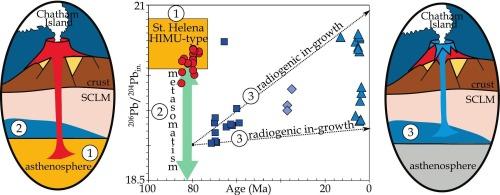Evidence for the transition from Cretaceous asthenospheric to Cenozoic lithospheric melting sources on the Chatham Islands, New Zealand
IF 7.2
1区 地球科学
Q1 GEOSCIENCES, MULTIDISCIPLINARY
引用次数: 0
Abstract
Late Cretaceous–Cenozoic diffuse intraplate volcanism is widespread across the continent of Zealandia, but only in the Chatham Islands have intraplate volcanoes erupted repeatedly for over 80 million years. Here we use new whole-rock major and trace element, and Sr-Nd-Pb-Hf isotope geochemical data from the Chatham Islands to characterize changes in the geochemical fingerprint of the melting sources over time to provide a better understanding of Zealandian intraplate volcanism. The first and most voluminous magmatic stage (∼85–75 Ma; Southern Volcanics) at the Chatham Islands has an isotopic signature nearly identical to the St. Helena HIMU-type end member. The following Red Bluff Tuff volcanic stage (∼65–50 Ma) has a distinct isotopic composition, influenced by an enriched mantle one-type, probably derived from the neighboring Hikurangi Plateau. The following magmatic stages, the Northern Volcanics (∼40–30 Ma) and Rangitihi Volcanics (< 10 Ma) extend from this compositional array to compositions with higher 206Pb/204Pb and 208Pb/204Pb ratios at given 207Pb/204Pb ratio. This ‘Cenozoic array’ reflects radiogenic in-growth with high U/Pb and Th/U ratios derived from a metasomatized lithospheric mantle source. The recorded temporal geochemical evolution confirms a widespread Late Cretaceous HIMU melting event in Zealandia, which metasomatized the lithospheric mantle forming the Cenozoic HIMU-like melting source. This also reflects a change from asthenospheric to lithospheric melting sources. The nearly continuous volcanism during the Cenozoic in the Chathams and wider eastern Chatham Rise could have been triggered by asthenospheric upwelling causing melting of the base of the metasomatized lithosphere. Considering the fast-northward motion of Zealandia during the Cenozoic (∼2500 km), the upwelling is most plausibly explained by the change in lithospheric thickness caused by the partly subducted Hikurangi Plateau that lies directly north of the Chatham Islands.

新西兰查塔姆群岛白垩纪软流圈向新生代岩石圈熔融源过渡的证据
晚白垩纪-新生代弥漫性板内火山作用在西兰迪亚大陆广泛存在,但只有查塔姆群岛的板内火山反复喷发了8000多万年。本文利用Chatham群岛新的全岩主微量元素和Sr-Nd-Pb-Hf同位素地球化学数据来表征熔融源的地球化学指纹随时间的变化,从而更好地了解新西兰板内火山作用。Chatham群岛的第一个也是最庞大的岩浆阶段(~ 85-75 Ma; Southern Volcanics)的同位素特征与圣赫勒拿himu型末端成员几乎相同。接下来的红崖凝灰岩火山阶段(~ 65 ~ 50 Ma)具有明显的同位素组成,受可能来自邻近的Hikurangi高原的富集地幔类型的影响。在此基础上,北部火山岩(~ 40 ~ 30 Ma)和Rangitihi火山岩(< 10 Ma)的岩浆阶段,在一定的207Pb/204Pb比值下,形成了较高的206Pb/204Pb和208Pb/204Pb比值。该“新生代阵列”反映了来自交代岩石圈地幔源的高U/Pb和Th/U比值的放射性成因生长。记录的时间地球化学演化证实了西兰迪亚晚白垩世广泛的HIMU熔融事件,该事件使岩石圈地幔交代,形成了新生代类似HIMU的熔融源。这也反映了熔融源由软流圈向岩石圈的转变。新生代查塔姆和更广泛的查塔姆东部隆起地区几乎连续不断的火山活动可能是由软流圈上升流引起的,软流圈上升流导致了交代岩石圈底部的融化。考虑到西兰迪亚在新生代(~ 2500公里)的快速北移,上升流最合理的解释是岩石圈厚度的变化是由部分俯冲的Hikurangi高原引起的,该高原位于查塔姆群岛的正北方。
本文章由计算机程序翻译,如有差异,请以英文原文为准。
求助全文
约1分钟内获得全文
求助全文
来源期刊

Gondwana Research
地学-地球科学综合
CiteScore
12.90
自引率
6.60%
发文量
298
审稿时长
65 days
期刊介绍:
Gondwana Research (GR) is an International Journal aimed to promote high quality research publications on all topics related to solid Earth, particularly with reference to the origin and evolution of continents, continental assemblies and their resources. GR is an "all earth science" journal with no restrictions on geological time, terrane or theme and covers a wide spectrum of topics in geosciences such as geology, geomorphology, palaeontology, structure, petrology, geochemistry, stable isotopes, geochronology, economic geology, exploration geology, engineering geology, geophysics, and environmental geology among other themes, and provides an appropriate forum to integrate studies from different disciplines and different terrains. In addition to regular articles and thematic issues, the journal invites high profile state-of-the-art reviews on thrust area topics for its column, ''GR FOCUS''. Focus articles include short biographies and photographs of the authors. Short articles (within ten printed pages) for rapid publication reporting important discoveries or innovative models of global interest will be considered under the category ''GR LETTERS''.
 求助内容:
求助内容: 应助结果提醒方式:
应助结果提醒方式:


